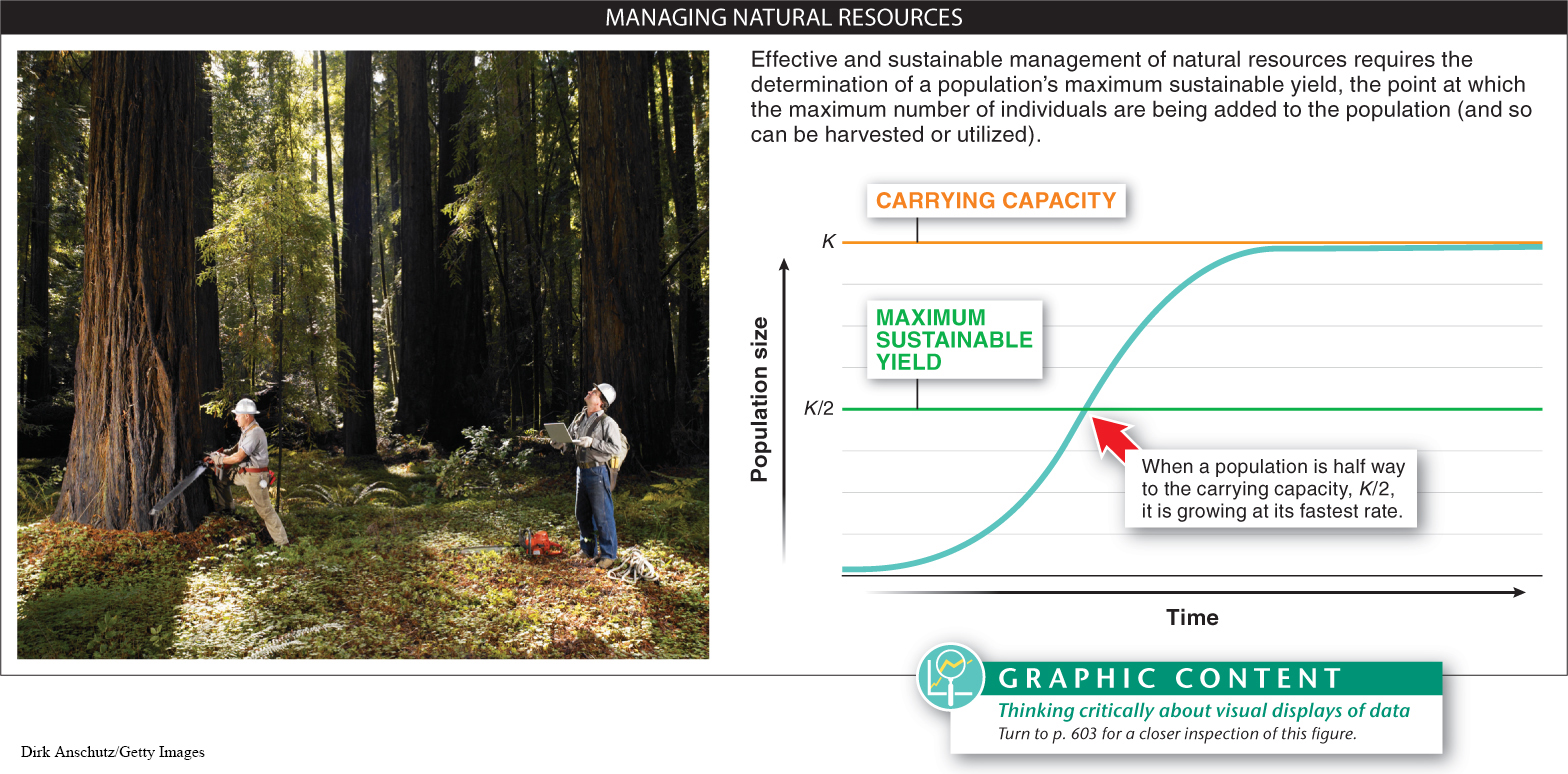Suppose you worked for a logging company and were responsible for selecting which trees in an eastern hardwood forest to cut down. Your responsibilities would be similar to those you’d have if you were in charge of the lobster fisheries discussed at the beginning of this chapter. In the case of the hardwood forest, how many trees would you cut down for maximum wood yield?
The maximum yield on any given day would be obtained by cutting everything down (known as clear-
What’s the better solution? For long-

Your first step as manager is to determine the maximum sustainable yield for the resource, calculated as the point at which the population is growing at its fastest rate. In Figure 14-6, we can see that in logistic growth, the population is getting larger at the fastest rate when its size is equal to half the carrying capacity. At this midpoint, scarcity of mates is not a problem, as it can be at low population levels, nor is competition a problem, as it can be near the carrying capacity—
Maximum sustainable yield is a useful concept, applicable not just to tree or lobster harvesting but also to managing nearly all natural resources. In fact, there are 31 official U.S. government agencies mandated to utilize the maximum sustainable yield concept in determining harvest levels. This is, however, nearly always an impossible task. Why is that so?
581
Almost all natural resource managers working for the U.S. government fail to do their job exactly as mandated. Why?
There are numerous reasons. For starters, if maximum sustainable yield occurs when a population is at half its carrying capacity, do we first wait until the population stabilizes at its carrying capacity to determine what half of that carrying capacity would be? But then isn’t it inefficient to sit around waiting for the population to reach its carrying capacity, when we want to maintain it at half that size? Or can we just estimate carrying capacity and then calculate half of it? But, for lobsters, won’t that be difficult, given that they live underwater? Put simply, we rarely know the value of K.
And the problem gets worse. For one thing, with many species, not only do we not know the carrying capacity, but we don’t even know the number of individuals currently living. It is difficult to accurately count humans, so imagine how hard it is to count individuals of species that live underwater, fly, or are microscopic.
And if we were to solve the mysteries of counting individuals and knowing the carrying capacity, we would still have to figure out whether carrying capacity is stable from year to year. For instance, if it depends on levels of resources, it may be cyclic. And even if we can figure out the carrying capacity and the population size, we would not be certain which individuals to harvest. Often, not all individuals in a population are contributing equally to population growth. The post-
As it turns out, harvesting natural resources for maximum efficiency generates insights into how to fight biological pests, such as cockroaches or termites (FIGURE 14-12). The problem is just turned on its head: which individuals in the pest population would you concentrate on killing so as to most effectively slow population growth? Those at the age of maturity, with the highest reproductive value, contribute most to the growth of the population. Similarly, because a population can still grow very rapidly with only a few males—

Patterns of population growth and the environmental features that influence them can lead to evolutionary changes in populations, shaping features such as life span, age of reproduction, number of offspring produced, and amount of offspring care—
TAKE-HOME MESSAGE 14.6
Based on models of population growth, it might seem easy to utilize natural resources efficiently and sustainably. In practice, however, difficulties such as estimating population size and carrying capacity complicate the implementation of such strategies.
What is meant by maximum sustainable yield?
Maximum sustainable yield is the point at which the maximum number of individuals are removed from a population without impairing its growth rate. The maximum sustainable yield occurs at half the carrying capacity. However, because it often is difficult to estimate a population’s current size or its carrying capacity, maximum sustainable yield is nearly impossible to determine.
582